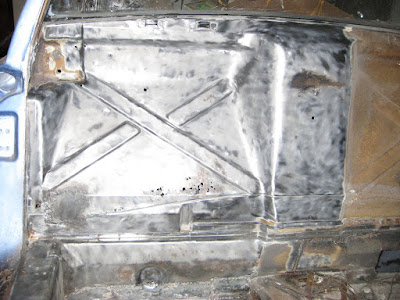October 2009 - I have been spending a considerable amount of time engineering a new digital dash solution for my 914 EV. While analog gauges are readily available, I believe that an EV should be a show piece and take advantage of the latest technologies including carputers and touch screen video displays.
Here is a shot of a standard 914 center console with clock, temperature and voltage gauges. While these gauges are OK for an ICE vehicle, they will not suffice for an EV.

An EV needs the following instrumentation: pack voltage, utility voltage, motor current, and state of charge. These four meters are available in 2 1/2" meters from
ElectroAuto for about $250. They would probably fit in a new console board with the gauges staggared diagonally but wouldn't give it that new technology look.
Obviously, a carputer will be necessary to implement my digitial dash solution and is not the topic for discussion at this time but in a later blog. Here is a shot of the MIT EVTeam's solution for a center console video display. I suspect my solution will be similar.

As you can see above, the bezel is too large for my liking. I will be using a Lilliput 7" Touchscreen display as shown below. While it is 7" diagonally, the width is 6" and will only cause the existing console to be widened minimally. I will also be using Microsoft's Windows Embedded technology as the carputer's operating system due to its very fast boot-time (15 secs) and its ability to be very secure. I estimate the OS' footprint at about 400MB including all of the executables for the front end, music player, digital dash interface, etc. Funny, all of my MP3s at ~20GB will dwarf the OS image.

I looked at a number of front ends for the carputer including RideRunner (formerly RoadRunner) and Centrafuse. I finally decided on RideRunner as it is currently free and has wide support from mp3car.com forums. Here's a shot of the RideRunner main menu screen with the Simplistique skin shown. As you can see, I've already altered the menu skin to incorporate my new dash component.

Here's a shot of the Music screen. I plan to have all of my mp3s on the carputer's 60GB hard drive (a Seagate ruggedized version) and a randomized playlist.

And here's the money shot of my digital dash. It includes a pack voltage meter, a utility voltage meter, a motor current meter, and a state of charge meter. The SOC meter is an interesting animal because you can implement it in one of 3 different ways: 1) voltage-based - least accurate, 2) specific-gravity-based - most accurate but unfeasable, and 3) direct-measurement - counting amp-hours. I decided to use direct measurement. As I will already be sampling the motor current, it will be simple to track the amp-hours used and count down from a known full charge level (resetting the meter after charging). The meters shown here are based on the "AGauge" .NET control currently available as open-source.

I'm putting a lot of effort into the digital dash as I really don't want to murder my first lead acid battery pack, a cost of anywhere from $1.2K - $2K. If you know your pack voltage, how many amps you are pulling from it, and how much power you have left in it, then almost anyone can keep from killing a pack unless you just totally ignore it. I'm hoping that my first SLA pack will be my last; I should be able to replace it with a Li-Ion pack for about $3K in about 3 years. And that should double or triple my range.
Here's a nice shot of another neat application available with RideRunner. Its a weather module using the Weather Channel's information available for any city, in this case Tampa, FL. Using the carputer's wireless network adaptor, I'll be able to access it while still in the garage.

Of course, many of you out there are wondering how I've engineered the interface. I discovered Fusion Control Centre's Fusion Brain; its a wonderful device that allows digital inputs and outputs.
Fusion Control Centre offers a number of sensors that interface directly with the Fusion Brain. Here's a shot of the Fusion Brain version 4 which I'm using; it runs about $60. It's literally the size of a credit card. BTW, the fusion brain connects to the carputer via a USB cable which also supplies power to the device.

I'm also using one of Fusion Control Centre's 4-Channel Opto Isolator and Voltage Divider boards to take the pack and utility voltages and convert them into 0-5 volt signals for the Fusion Brain. I really like the board because it is relatively inexpensive compared to the Fusion Brain and it optically isolates the input voltages from the output voltages, so if any of the input voltages spike, they won't take out the Fusion Brain. The opto isolator board sells for about $18. It also has places on the board to mount addtional resistors if you have a voltage other than 7V or 15V which are their defaults. In the case of the 120V input, I'll need to add a 5K resistor.

As the feed for the motor current gauge is taken from the 500 amp shunt built into the EVHelp 144 volt dc controller, its 0-50mV output will need to be amplified about 100X by an op-amp circuit board. This is a relatively simple circuit that is easily "googled" and breadboarded. The 100X amplification should give me a nice 5-volt signal for direct feed to the Fusion Brain. Here is a logical connection diagram for all of the components thus far discussed.













































